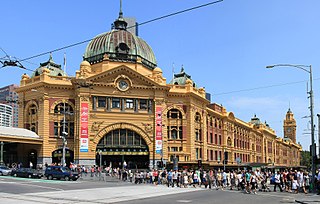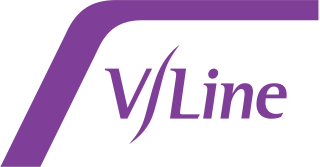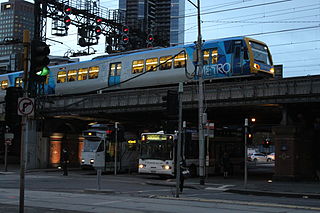
Trams are a major form of public transport in Melbourne, the capital city of the state of Victoria, Australia. As of May 2017, the Melbourne tramway network consists of 250 kilometres of double track, 493 trams, 24 routes, and 1,763 tram stops. The system is the largest operational urban tram network in the world. Trams are the second most used form of public transport in overall boardings in Melbourne after the commuter railway network, with a total of 206 million passenger trips in 2017–18.

Docklands is an inner suburb of Melbourne, Victoria, Australia, 2 km (1.2 mi) west of the city's Central Business District (CBD). Its local government area is the City of Melbourne. At the 2016 Census, Docklands had a population of 10,964. Primarily a waterfront area centred on the banks of the Yarra River, it is bounded by Wurundjeri Way and the Charles Grimes Bridge to the east, CityLink to the west and Lorimer Street across the Yarra to the south.

The City of Melbourne is a local government area in Victoria, Australia, located in the central city area of Melbourne. In 2018 the city has an area of 37 square kilometres (14 sq mi) and had a population of 169,961. The city's motto is "Vires acquirit eundo" which means "She gathers strength as she goes."

Dandenong is a suburb of Melbourne, 35 km (22 mi) south-east from the CBD. Situated on the northwest bank of the Dandenong Creek, it is 21.6 km (13.4 mi) from the namesake Dandenong Ranges to its northeast and completely unrelated in both location and nature. It is the administrative centre for the City of Greater Dandenong local government area. At the 2016 census, central Dandenong had a population of 29,906.

The Melbourne rail network is a passenger and freight train system in the city of Melbourne, Victoria, Australia. It is the core of the larger Victorian railway network, with links to both intrastate and interstate systems. A large suburban passenger network centred on the CBD also operates, with a limited degree of segregation from longer-distance passenger and freight trains.

V/Line is a government-owned corporation that operates regional passenger train and coach services in Victoria, Australia. It provides passenger train services on five commuter lines and eight long-distance routes from its major hub at Southern Cross railway station in Melbourne, as well as bus services across Victoria and into New South Wales, the Australian Capital Territory and South Australia. In addition, V/Line is responsible for the maintenance of much of the Victorian freight and passenger rail network outside of the areas managed by Metro Trains Melbourne and the Australian Rail Track Corporation.

Victoria Street is one of the major thoroughfares of inner Melbourne, running east–west for over six kilometres between Munster Terrace in North Melbourne and the Yarra River. The road is known as Victoria Parade for over one-and-a-half kilometres of its length, distinguishable with a wide reservation and tramway down the middle.

Transport in Melbourne, the state capital of Victoria, Australia, consists of several interlinking modes. Melbourne is a hub for intercity, intracity and regional travel. Road-based transport accounts for most trips across many parts of the city, facilitated by Australia's largest freeway network. Public transport, including the world's largest tram network, trains and buses, also forms a key part of the transport system. Other dominant modes include walking, cycling and commercial-passenger vehicle services such as taxis. Melbourne is a busy regional transport hub for the statewide passenger rail network, coaches and interstate rail services to New South Wales and South Australia. Freight transport also makes up a significant proportion of trips made on the network from the Port of Melbourne, Melbourne Airport and industrial areas across the city.
VicRoads or the Roads Corporation of Victoria is a statutory corporation in the state of Victoria, Australia. In the state, it is responsible for driver licensing and vehicle registration, and regulating the accident towing industry in Victoria. It is part of the Department of Transport.
An urban enterprise zone is an area in which policies to encourage economic growth and development are implemented. Urban enterprise zone policies generally offer tax concessions, infrastructure incentives, and reduced regulations to attract investments and private companies into the zones. They are a type of special economic zone where companies can locate free of certain local, state, and federal taxes and restrictions. Urban enterprise zones are intended to encourage development in deprived neighborhoods through tax and regulatory relief to entrepreneurs and investors who launch businesses in the area.

Fishermans Bend is a precinct within the City of Port Phillip and the City of Melbourne. It is located on the south of the Yarra River in the suburb of Port Melbourne and opposite Coode Island, close to Melbourne city centre. Fishermans Bend originally included the area now known as Garden City, which was renamed in 1929.

VicTrack, the trading name of Victorian Rail Track Corporation, is a Victorian Government state-owned enterprise which owns all railway and tram lines, associated rail lands and other rail-related infrastructure in the state of Victoria, Australia, with the exception of the Emerald Tourist Railway Board's heritage Puffing Billy Railway.
Honeysuckle is a near completed 50 hectare residential and commercial urban renewal redevelopment of former industrial land along Newcastle Harbour in New South Wales, Australia.

The Transport Integration Act 2010 is a law enacted by the Parliament of the State of Victoria, Australia. The Act is the prime transport statute in Victoria, having replaced major parts of the Transport Act 1983, which was renamed as the Transport Act 1983.

Public Transport Victoria is the brand name for public transport in the Australian state of Victoria. It was the trading name of the Public Transport Development Authority (PTDA), a now-defunct statutory authority in Victoria, responsible for providing, coordinating, and promoting public transport.

The Level Crossing Removal Project (LXRP) is a program of the Government of Victoria, Australia, to remove 85 level crossings in Melbourne. After pledging the removal of 50 level crossings at the 2014 Victorian state election, the Andrews Government committed $2.4 billion in the 2015–2016 budget to remove the first 20 crossings by 2018. The remaining 30 are planned to be completed by 2022 at an estimated cost of $6 billion, which was funded through the privatisation of the Port of Melbourne. Prior to the 2018 state election, the Government committed to remove a further 25 level crossings, using a new prioritisation framework. In 2021 the government announced a further 10 level crossing removals and 4 level crossing closures would occur by 2025, bringing the total planned level crossing removals to 85 by 2025. As of September 2021, 47 crossings had been removed and 26 train stations had been rebuilt as part of the project. Previously its own administrative agency, in 2019 the LXRP became a project within the Major Transport Infrastructure Authority, an office of the Victorian Department of Transport.

Harbour Esplanade is a waterfront street and thoroughfare in Docklands, an inner suburb of Melbourne, Victoria, Australia. It runs roughly north-south from Navigation Drive in the south to Docklands Drive in the north. The road also forms the eastern boundary of the Victoria Harbour inlet and is adjacent to Victoria Dock.
The Department of Economic Development, Jobs, Transport and Resources (DEDJTR) is a former department of the Government of Victoria. It was created on 1 January 2015 by the government of Premier Daniel Andrews when the number of government departments was reduced from 9 to 7, and assumed responsibility for ministerial portfolios previously spread across 5 departments. It was abolished at the end of 2018 and divided into two new departments.
The Department of Transport (DOT) is a government department in Victoria, Australia. Commencing operation on 1 January 2019, it is responsible for ongoing operation and coordination of the state's transport networks, as well as the delivery of new and upgraded transport infrastructure. It also absorbed most functions of VicRoads and Public Transport Victoria on 1 July 2019.














